Affiliate disclosure: This post may contain affiliate links. Please see our Privacy Policy.
Making tepache with pineapple scraps is a fun and rewarding way to turn kitchen waste into a delicious, lightly fermented drink. With just a few ingredients and a couple of days, you can create a naturally fizzy, probiotic beverage that tastes like tropical sunshine—even in the middle of winter.
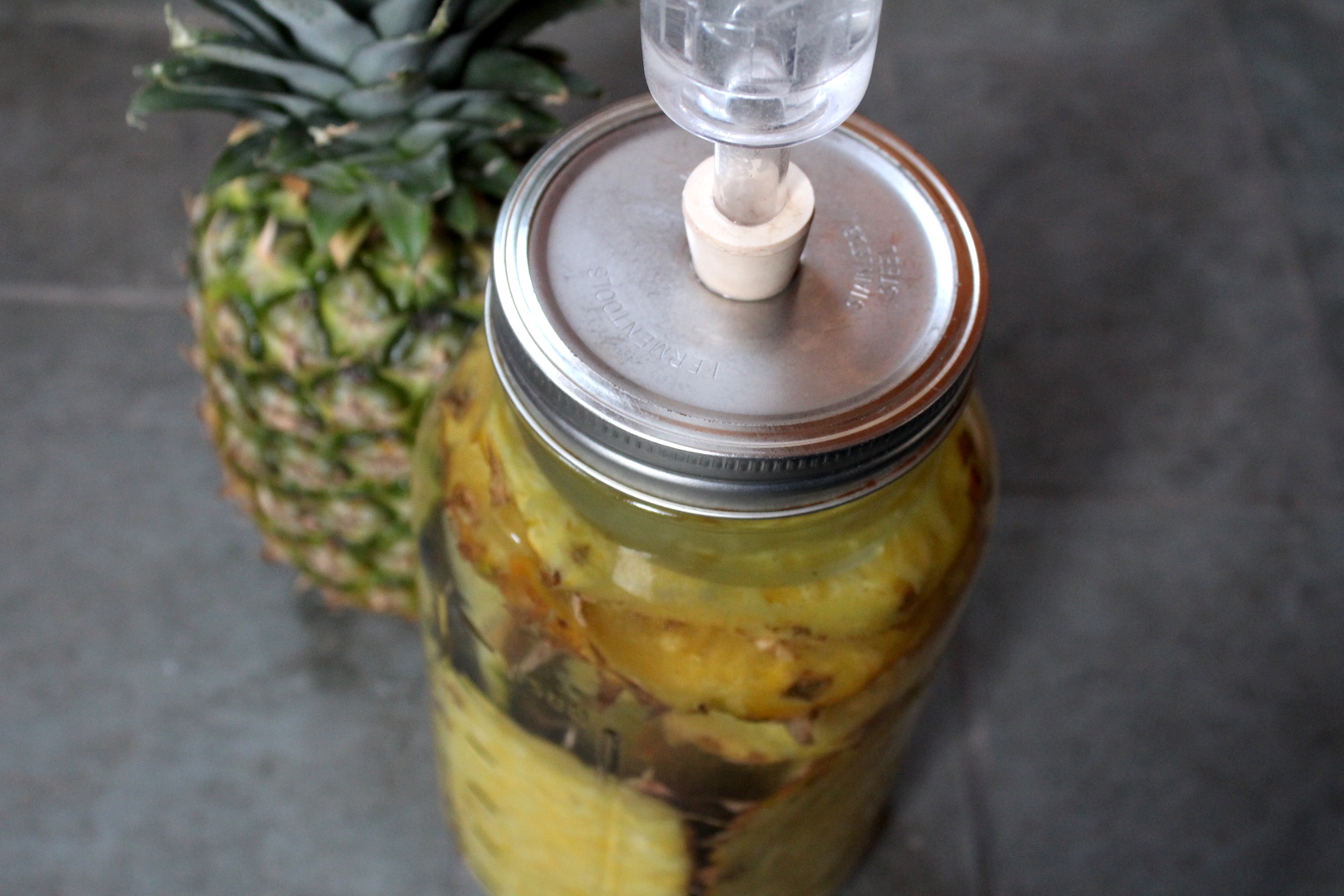
In the depths of winter, I know I should be sticking to homegrown storage crops and locally preserved food—but I still can’t resist pineapple. Every January, they go on sale for about a dollar each around here, and I stock up and my kitchen turns into a factory for canning pineapple, making pineapple jam and we even make a few gallons of pineapple wine.
After canning jars full and my wine is bubbling away, I’m left with a towering pile of pineapple peels that feels too good to waste.
Sure, the compost worms are happy with the leftovers—but they can wait their turn. There’s still flavor and value in those scraps, and that’s where tepache comes in.
Tepache is a traditional South American fermented drink made from pineapple peels, sugar, and spices. It’s fizzy, just a little bit boozy, and naturally probiotic. I first stumbled across the recipe in the All New Ball Book of Canning and Preserving, which is full of unexpected and creative preservation ideas. This one instantly caught my attention because it turns waste into something delicious.
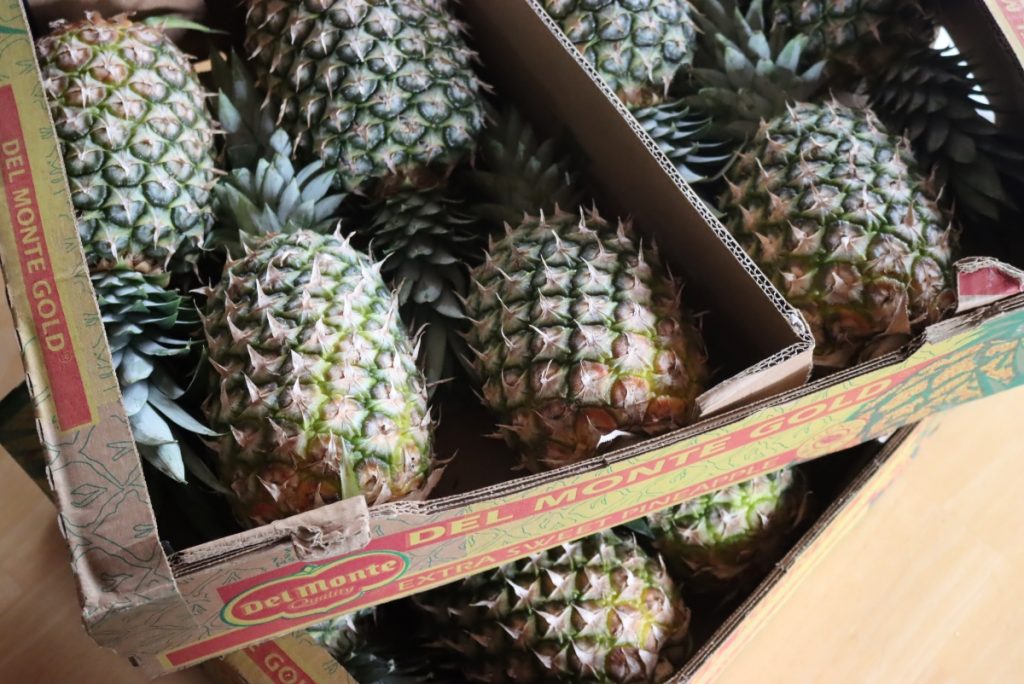
What is Tepache?
Tepache de piña is a naturally fermented Mexican drink made by steeping pineapple peels in sugar water, often with cinnamon and cloves for flavor. It’s lightly fermented, so it ends up slightly alcoholic—though traditionally, a bit of beer might be added if you want to increase the alcohol content.
Because the fermentation time is short (usually 2 to 3 days), tepache stays on the sweet and refreshing side rather than becoming vinegary. It’s a perfect beginner fermentation project and a great way to get more out of your fruit scraps.
Fermenting Tepache at Home
To make tepache, you’ll want a basic fermentation kit, which includes an airlock that fits onto a mason jar. These lids allow gas to escape during fermentation but keep bacteria, mold, and wild yeasts out—helping you avoid spoilage or off-flavors. These days, I use Mason Tops Pickle Pipes, which are a silicone fermentation lid that works wonderfully and is easy to clean.
(The pictures are from a more complicated fermentation setup that’s not on the market anymore, but the simple silicone ones from mason tops are great and they’re all I use these days.)
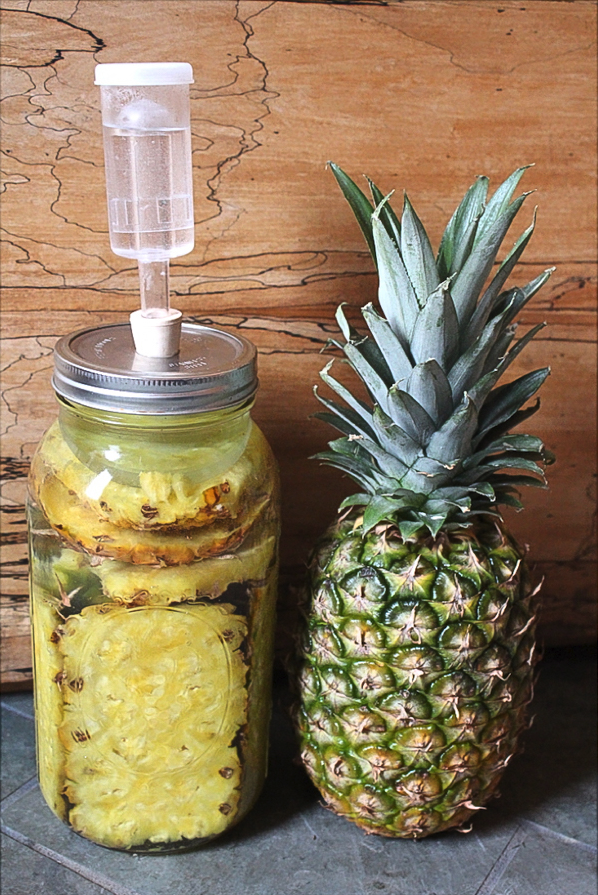
Choosing Sugar for Tepache
Traditionally, piloncillo (a raw cane sugar commonly used in Latin American cooking) is used to make tepache, giving the drink its signature dark, caramel color and deep molasses-like flavor. I used raw cane sugar for this batch, which added a nice fruity brightness, but it didn’t have quite the richness I was hoping for. Next time, I’m tracking down piloncillo for a more authentic flavor.
You can also use brown sugar if you can’t find piloncillo—it works well and adds more body than plain white sugar.
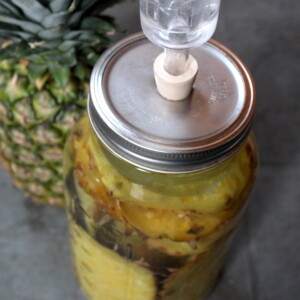
Tepache Recipe (with Pineapple Scraps)
Ingredients
- 1 to 1 ¼ cups piloncillo, or brown sugar, raw cane sugar also works
- Peels and cores from 1–2 pineapples, washed thoroughly
- 6 cups warm water
- 1 cinnamon stick, optional
- 2 whole cloves, optional
Instructions
- Prep the Pineapple: Start by washing your pineapple thoroughly. Cut off the top and bottom, then slice vertical strips to remove the peel. Cut the pineapple into quarters and remove the fibrous cores. Set aside the fruit for canning or fresh eating—tepache uses only the scraps.
- Pack the Jar: Place the pineapple peels and cores into a clean wide-mouth half-gallon mason jar. Add the cinnamon stick and cloves if you’re using them.
- Add Sugar and Water: Dissolve the sugar in warm (not hot) water and pour it over the pineapple scraps, leaving at least 1 inch of headspace in the jar.
- Ferment: Attach your fermentation lid or airlock and let the jar sit at room temperature for 24 to 72 hours. You’ll notice bubbles forming as the fermentation gets going. Taste it after the first day, and once it reaches your preferred level of tartness and fizz, it’s ready for the next step.
- Strain and Carbonate: Remove the fermentation lid and strain the liquid through a fine mesh strainer or cheesecloth. Transfer the strained liquid to a clean mason jar, seal it with a standard lid, and let it sit at room temperature for another 6 to 12 hours to build carbonation.
- Store and Serve: Once it's lightly fizzy, move the jar to the refrigerator. Your tepache should keep for about two weeks—but chances are, it’ll be gone well before then.
Notes
Nutrition
Nutrition information is automatically calculated, so should only be used as an approximation.
Fermentation Projects
Making tepache with pineapple scraps is one of those win-win homestead projects—it reduces waste, builds your fermentation skills, and creates a refreshing, probiotic drink with a hint of natural sweetness. Once you try it, you might find yourself buying an extra pineapple just to make another batch.
Even if you’re dedicated to local food and homegrown fruit, sometimes a little tropical indulgence is worth it. Especially when you can turn the scraps into something this good.
You can do a similar thing with apple peels to make a fizzy, probiotic drink if you want to keep it local. You can also let it go a bit further, and turn that same drink into apple scrap vinegar.
If you’re looking for more quick, probiotic drinks, try making fermented lemonade for a fizzy refreshing summer drink, or water kefir, for a natural probiotic soda.
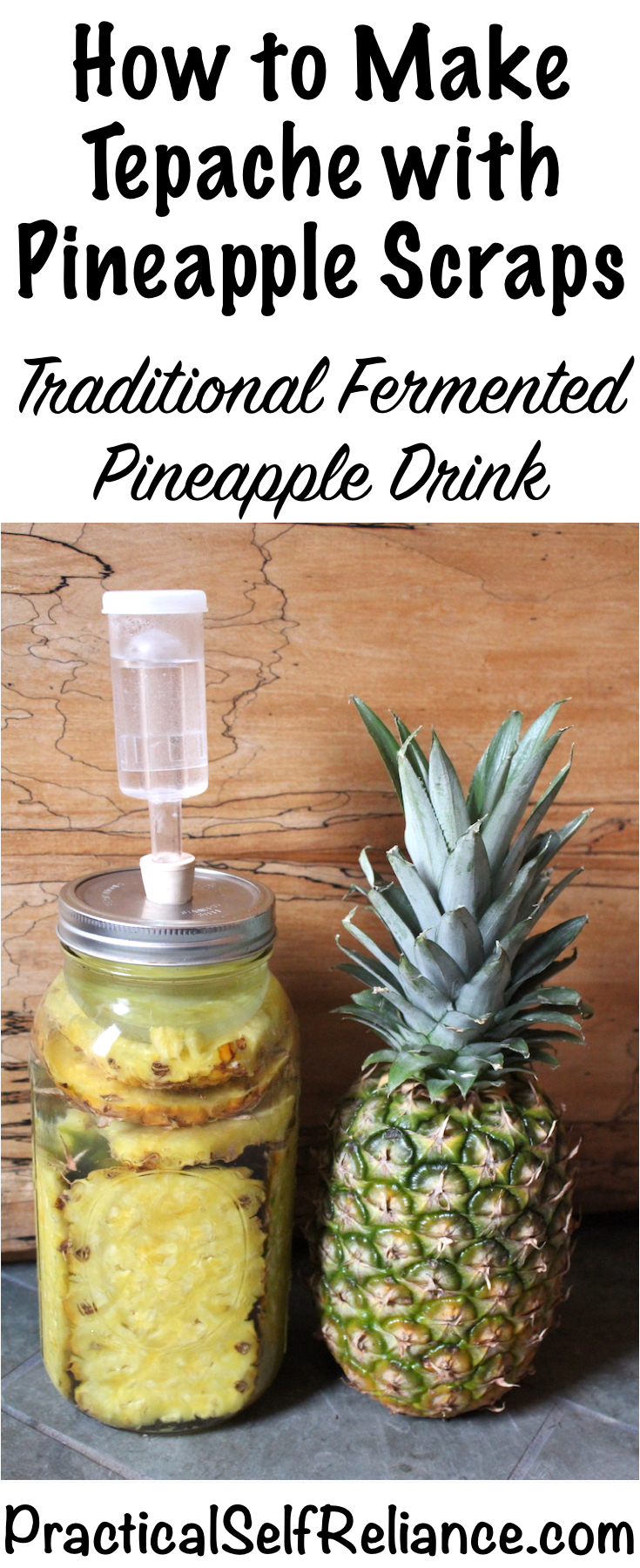

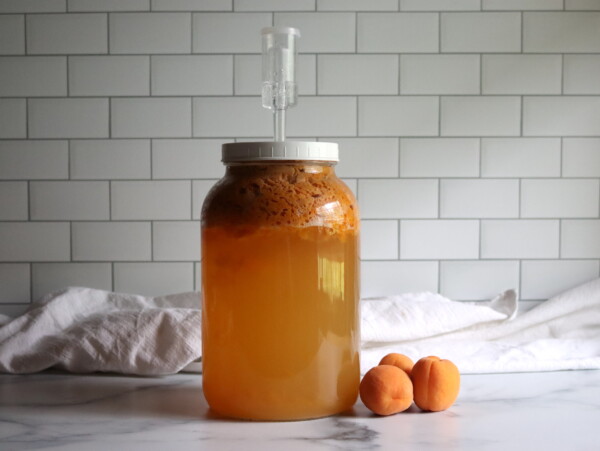
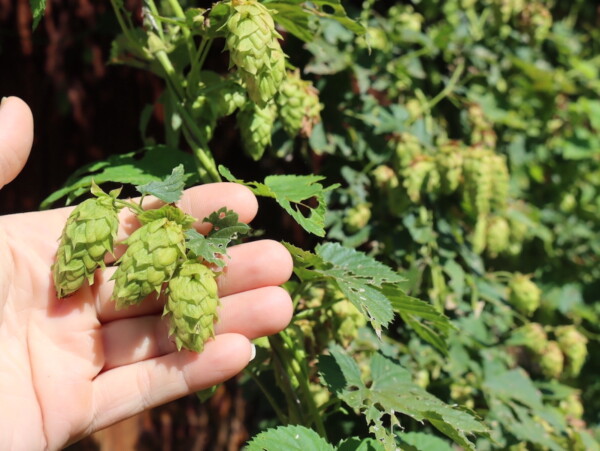
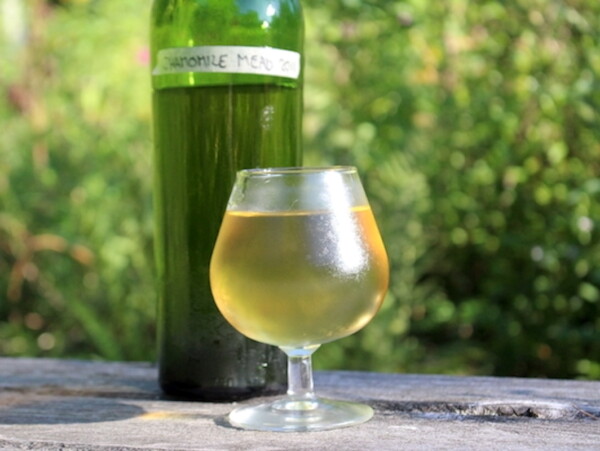










Coming back to look up the recipe to make this again. Just wanted to say we had some of our first batch (we did a big canning session) for about a year in the fridge, no problem at all. Still tastes delicious. It really didn’t get that much more fermented, the fridge really slowed it down even more than expected. I think as long as you put it in the fridge and don’t open it after the final ferment, you don’t need to worry about bacteria growth if you started with sterile jars. Of course once you open it to have some, you’ll be risking introduction of bacteria, so we always drink it up within a few days.
Thanks for sharing.
Can you freeze the pineapple skins and make at a later date? Do you need the Core? My pup loves the cores….
You can skip the core if you like, and yes, you can freeze them for later.
Can you talk about how to properly wash the pineapple since it traveled a long way with exposed skin. Can you also talk about proper cleaning and sanitizing of kitchen tools and countertops. Please include bread boards, pots and pans and dish towels and sponges. Thank you.
This post was intended to be a quick tutorial about making Tepache. This information is certainly important but that is more information than we are able to include in a simple blog post.
Dear administrator…I am duly chastised. It won’t happen again.
Do you have to add the full cup of sugar are there any substitutes for sugar that would work in this recipe?
No, the yeast feed on the sugar so when you drink it, there is little sugar left. The longer you ferment, the lower the end sugar content, if any. I let mine go at least 3 days and it is quite tart.
Have you tried keeping it longer than 2 weeks? Is there a way to bottle it for shelf stable longer term storage? It sounds awsome & i can’t wait to make some. And if it is a max 2 week shelf life then twist my arm guess I’m throwing a party lol.
I bottle my Tepache for a second ferment and then store the bottles in the refrigerator. I first make a batch of tepache with pineapple skins, brown sugar, spices, and water. After it starts to foam up (for me about 48 hours), I let it ferment for 24 more hours. Then I filter and transfer it into swing top or store-bought kombucha bottles that can handle the pressure. I let the bottles sit at room temperature for another 2 days and then refrigerate. I start drinking them very cold the next day, and they are tart and slightly sweet with some nice fizz. I think these bottles will last in the refrigerator for several weeks or more, but they slowly continue to ferment, and the taste will change.
A pharmacist friend told me that potent pesticides are used on pineapples. I stopped making something similar due to this info. How do you wash the pineapples? Do you worry about pesticides?
For my own use, I’ve stopped making this with anything other than organic pineapples. But that said, unless you’re on an all organic diet the companies packaging prepared foods are making pesticide-laden food every day. A can of tomatoes from conventionally sprayed crops or even just applesauce. Those are some of the heaviest sprayed fruits you can buy, and they’re eaten all the time. I’d worry much more about that then a very occasionally made drink from pineapple peels once or twice a year.
AG. When my husband and I use store bought produce we wash the it with a mixture of benanite clay and water.
Can you substitute the beer for white wine?
Yes, of course. This would be delicious in white wine.
Prosecco!
I used a plastic pitcher for about 5 days now it has few white patches on top,
I’m scared to use it
Looks like you got mold contamination. In most cases, it’s still fine, just scoop the mold off the top, but obviously, you have to use your best judgment because you’re the one that’s drinking it (and I’m not a doctor or a microbiologist…). If you’re using an open fermenter like a pitcher, fill a Ziploc bag with water and place that on the top. That’ll hold everything under the waterline and help prevent surface mold.
The “white patch” may no be mold at all but a certain kind of yeast bloom. If that, completely benign. Just “spoon it away”.
Maybe I missed it but I don’t think you said what type of yeast you use? The only reason I ask is because there are so many different types out there
This recipe is a wild ferment with no added yeast. You’re relying on natural yeast present on the fruit, and it worked wonderfully for me. If you’d prefer, feel free to add a wine yeast.
I just bottled my first batch, have you ever made a second batch with the same pineapple?
Awesome! No, I’ve never used the same pineapple twice. I would think that most the sugars and flavor would be in the first batch. I do use the vegetables and bones twice when I’m making bone broth, and the second batch is always tasty too. So maybe there’s enough pineapple flavor left, give it a try! I’d love to hear your results.
I was so excited to find this recipe for my pineapple peeling. I had the silicone mason jar lids so it was easy! It was delicious!! I then put more sugar and water trying the same peel Ings for a second time. It was delicious! So I am trying it for the third time
Wonderful, so glad you enjoyed it!
I have read you can use it THREE times! There are different things to do in each stage..